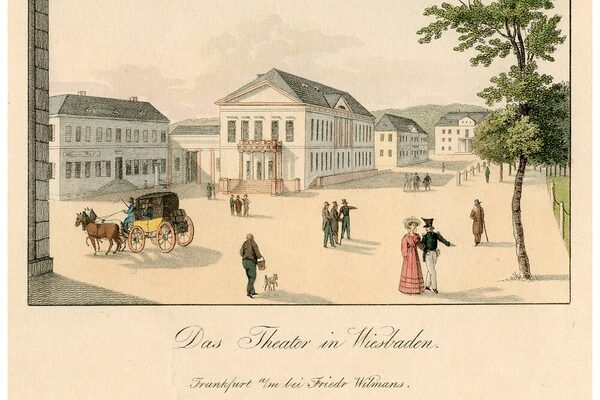Theater in Wiesbaden - History until 1894
Before the beginning of Wiesbaden's actual theater history in 1765, the city was only occasionally visited by passing acting troupes. In this year, Prince Karl zu Nassau-Usingen granted a concession to the traveling stage of the comedian Carl Porch, which stipulated that Porch and his "gang" should set up a stage during the spa season and perform two to three times a week in return for a public fee of two guilders.
When Prince Karl Wilhelm zu Nassau-Usingen came to power in 1785, more sophisticated theater was introduced and the companies were selected more critically. From the end of the 1770s, a covered wooden round building in the Herrengarten served as a comedy house. In 1802, Reinhard Kässberger, the landlord of the Badhaus zum Einhorn, received an advance from the court treasury to set up a permanent venue in the Schützenhof. This was now also frequented by the Nassau court; the court box is even said to have been very popular with the Duke and Duchess. In 1810, Carl August Freiherr von Ungern-Sternberg (1777-1847) was appointed director of the "ducal Nassau court theater" with a permanent ensemble.
This first heyday ended in 1813 with the political upheavals brought about by the collapse of Napoleon's army and the end of the Confederation of the Rhine; the permanent ensemble disbanded and the Wiesbaden theater was once again used by companies from abroad. Duke Wilhelm zu Nassau-Weilburg, who had taken office in 1816, entered into a union with the Mainz Theater, which had been performing at the Schützenhof since 1817, for the 1819/20 season; it lasted for almost 20 years.
The Schützenhofsaal was used as a court theater until 1827 and was demolished in 1865. Plans for the construction of a separate theater began to take shape in 1824: Building councillor Heinrich Jacob Zengerle was commissioned to compile sketches and plans of theaters that could hold 800 to 1,000 people. In the end, the decision was made to follow the example of Aachen's municipal theater. Master builder Eberhard Philipp Wolff (1773-1843) erected a classicist theater building on the corner of Wilhelmstraße and today's Kaiser-Friedrich-Platz in 1825-27. The ceremonial opening took place on 26.06.1827.
The theater had the shape of an amphitheater; behind it was a magazine building. The walls were painted in reddish-grey marble. The decorations came from the Orth brothers in Munich, the theater machinery from Dorn in Darmstadt. The interior was decorated with, among other things, a view of Biebrich and numerous other "leaflets". The harmonious overall effect of the building was praised.
With the accession of Duke Adolph, Wiesbaden received its own permanent theater ensemble under Court Marshal Carl von Bose and Director Karl Beurer. One of the highlights of the theater's history at this time was a concert with Franz Liszt on 30.07.1840. When the Biebrich court orchestra was dissolved that year, its members were integrated into the theater orchestra. Christian Rummel, previously conductor of the Biebrich court orchestra, became court conductor. In 1848, the year of the revolution, the duke was deprived of his income from the domain coffers, whereupon he cut off the theater's subsidies. In order to maintain operations despite this, the theater was managed by a bourgeois theater commission until 1857, with the city providing the necessary subsidies. Duke Adolph then subsidized the theater again. Director Friedrich von Bose, son of Carl von Bose, implemented important reforms such as the introduction of the so-called Theater Disciplinary Laws and founded a pension institution for the members. He also introduced a separation of the ensembles for musical theater and drama with a separate director for each division.
At this time, a new building had already been under discussion for some time. In 1860, master builder Philipp Hoffmann presented an initial design. In 1866, the Nassau Theatre became the Royal Prussian Court Theatre. Like those in Hanover and Kassel, the theater was now under the general management of the Königliche Schauspiele Berlin with general manager Botho von Hülsen. With the opening of the new building in 1894, the old theater had served its purpose and was demolished in 1896.
Literature
Hildebrand, Alexander/Vollmer, Eva Christina/Roland, Karl Heinz: Hessisches Staatstheater in Wiesbaden - Theater in Wiesbaden 1765-1978, Wiesbaden 1978.
Hack, Elke (editor): Repertorien des Hessischen Hauptstaatsarchivs Wiesbaden. Dept. 428: Wiesbaden State Theater. Files and printed matter 1810-1996. ed.: Hessian Main State Archives Wiesbaden, Wiesbaden 1997.
Weddigen, Otto: History of the Royal Theater in Wiesbaden, Wiesbaden 1894.
